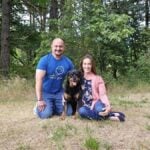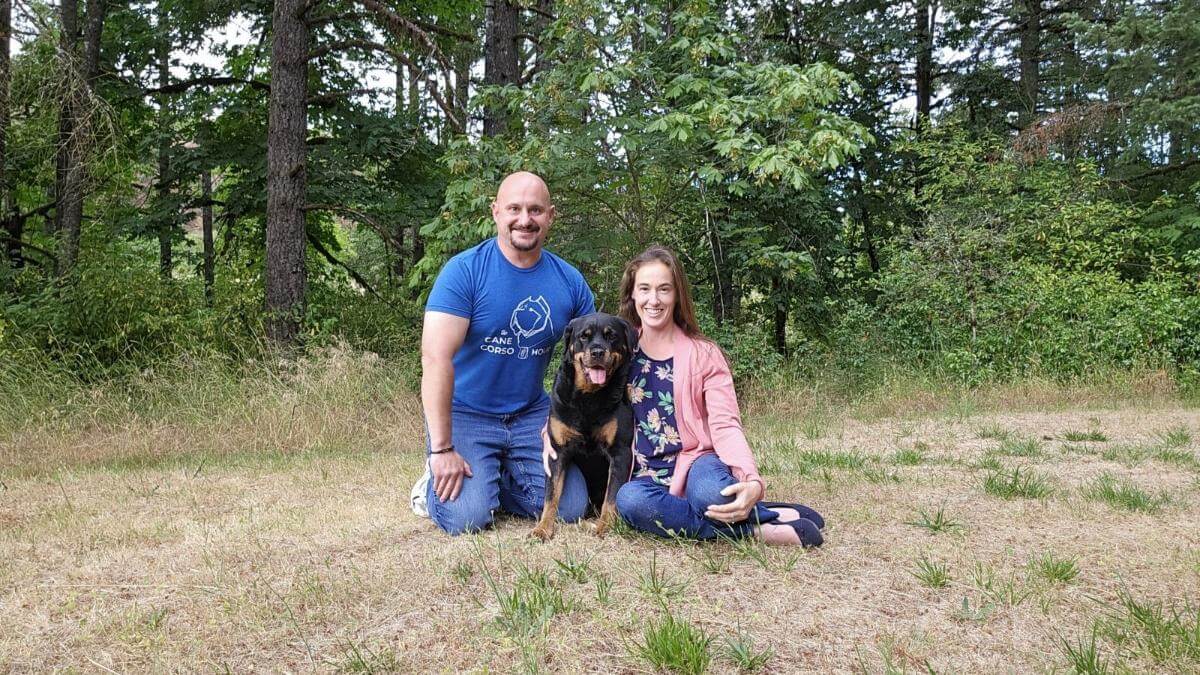


Home » David Bert & Christina Ulberg | 2infinity Rottweilers

David Bert & Christina Ulberg
1. My Husband (David Bert) and I (Christina Ulberg) have been in Rottweilers formally since 2004. I chose a chubby, slow one named Don Diago Vom Neuenschloss, call name Diago, and started our journey. I worked for the State of Oregon for years and balanced showing our dogs with work. We live in the outskirts of Dallas, Oregon, and have space that allows them to run. We had our first litter in 2011 and established dogs under our kennel name: 2Infinity Rottweilers. I am excited that this year is our 21st anniversary in the breed. In 2024, we had our first two homegrown Top 20 dogs, Favor and Storm. We are excited about how we have matured as a breeding program and that we can showcase our dogs to others.
2. The Rottweiler is the butcher’s dog and designed to be the workhorse for the butcher. They are a multi-skilled dog, delivering on practically everything asked of it. I would say the hallmark of the breed are the black and mahogany markings, as they are distinct and very clear. To maintain breed type, the dogs need to function athletically to perform—herding, carting, tracking, etc.
The current trend that is sparking debate is the change in head type to almost a Boxer-style muzzle. This will make our strong breed present as if it is brachiocephalic, and the dogs would no longer will be able to perform the functions they were bred for. The American Rottweiler Club (ARC) is working on education to ensure that we encourage breeding practices that strive for our Breed Standard.
3. We pride ourselves on being different when it comes to litters. We breed when we want something (maybe one a year), not when others want something. We breed for our next show dog and people are fortunate enough to get lovely dogs from those litters that are designed for the show ring. We typically keep something from the litter to improve and develop the breeding program. If we feel that the litter was not up to our standards, we find amazing homes.
Puppy homes are like the ocean; they come in waves, as well as desired male and female trends. We find that the sex you have available is always on the downturn of the wave from what the people are wanting. We are again fortunate enough to have found consistent homes that continue to return to us to add new dogs. Plus, we encourage other breeders to think logically. Just because a bitch comes in season, do you really need puppies, and can you find homes? Don’t just breed to breed! Breed to better the breed!
4. The ARC has partnered with a program establishing a Rottweiler Archive. This has allowed a centralized place to store dog information (health, pedigree, etc.) that allows users to input test breedings to see Coefficient of Breeding results, pedigree analysis, and compare health testing. This database has opened eyes for the need for complete health testing and has allowed the conversation with breeders to perform not just the basic tests, but also above and beyond DNA-style tests to ward off possible issues that can be avoided easily.
University of California, Davis has some amazing Rottweiler testing that can show a full story of any dog. Science is evolving, and we continue to play catch up, but that is okay, because at least we are trying to remain educated about the ever-changing developments. We are dedicated as breeders to stay with, and try to get ahead of, these advancements.
5. In Oregon, we have been recently faced with a bill detrimental to purebred dogs and dog breeders, additionally affecting dog sports. With that in mind, purebred dogs have not had enough positive publicity to draw attention to the positive things they offer people and a community. Given we do not have the same budget and pull that shelters and rescues have, we cannot offer enough of the good side; people only see the aftermath of poorly bred dogs surrendered or abandoned. You will NEVER see a 2Infinity dog in any of those situations, as we vet our people and check in frequently. The pendulum needs to swing back towards purebred again as the best option.
I am excited to say that during a lovely lunch with our veterinarian I was pleased to hear that we have set the bar high for Rottweilers. She said that we have such lovely temperaments and sound health that she can easily see the thought and art put into their creation. She feels fortunate to have such great representatives of the breed in her clinic and has bragged frequently to other people about our dogs. I am so proud to have received such a compliment.
6. One big trend is that most of the knowledge in the breed resides with the aging generation, who holds it close and tight. I am confident in saying that a big challenge we face moving forward with the breed and the sport is encouraging and attracting Juniors and younger generations!
We need to find ways to inspire and encourage Juniors to continue our pedigrees and breeding practices. Additionally, showing them that dog shows as a sport is rewarding. Mentorship within our breed should be encouraged, especially with Juniors. Teach them structure, which health testing is needed, how the dog they show came to be, and most of all, how to professionally present the dogs at shows. Yes, we have handling clinics, but we should consider breed seminars for Juniors like those offered to Judges. We need to include the parents in the sport, showing them that this is a structured environment worth encouraging Juniors to follow. It is only then that we can pass this knowledge down and continue growth. We need to look towards the future and how this younger generation can help us—stop living in the past, live for tomorrow.
7. From the COVID scare, a pilot program was created to allow Juniors to use dogs they did not co-own. This is parallel to Canada and how they encourage Juniors to expand their skills. I was excited for the change as it has allowed our Junior assistant to really explore different breeds and create an amazing style. This kind of change, to help teach Juniors, is exactly what can keep Juniors coming back! I am excited to see how the Juniors surpass my skill set and knowledge. My assistant has also met some amazing breeders who will be lifelong family; additionally, she has more respect for each breed she encounters. Without that program change she might have never had that opportunity. Our community is supportive, and this allowed her to experience it fully!